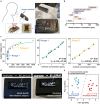Nanowire Array Breath Acetone Sensor for Diabetes Monitoring
- PMID: 38477429
- PMCID: PMC11109654
- DOI: 10.1002/advs.202309481
Nanowire Array Breath Acetone Sensor for Diabetes Monitoring
Abstract
Diabetic ketoacidosis (DKA) is a life-threatening acute complication of diabetes characterized by the accumulation of ketone bodies in the blood. Breath acetone, a ketone, directly correlates with blood ketones. Therefore, monitoring breath acetone can significantly enhance the safety and efficacy of diabetes care. In this work, the design and fabrication of an InP/Pt/chitosan nanowire array-based chemiresistive acetone sensor is reported. By incorporation of chitosan as a surface-functional layer and a Pt Schottky contact for efficient charge transfer processes and photovoltaic effect, self-powered, highly selective acetone sensing is achieved. The sensor has exhibited an ultra-wide acetone detection range from sub-ppb to >100 000 ppm level at room temperature, covering those in the exhaled breath from healthy individuals (300-800 ppb) to people at high risk of DKA (>75 ppm). The nanowire sensor has also been successfully integrated into a handheld breath testing prototype, the Ketowhistle, which can successfully detect different ranges of acetone concentrations in simulated breath samples. The Ketowhistle demonstrates the immediate potential for non-invasive ketone monitoring for people living with diabetes, in particular for DKA prevention.
Keywords: Diabetic ketoacidosis; InP nanowires; acetone sensor; breath test prototype; chitosan.
© 2024 The Authors. Advanced Science published by Wiley‐VCH GmbH.
Conflict of interest statement
The authors have filed a provisional patent for this work.
Figures





Similar articles
-
Is Breath Best? A Systematic Review on the Accuracy and Utility of Nanotechnology Based Breath Analysis of Ketones in Type 1 Diabetes.Biosensors (Basel). 2025 Jan 19;15(1):62. doi: 10.3390/bios15010062. Biosensors (Basel). 2025. PMID: 39852113 Free PMC article.
-
Mixed Potential Type Acetone Sensor with Ultralow Detection Limit for Diabetic Ketosis Breath Analysis.ACS Sens. 2024 Jan 26;9(1):464-473. doi: 10.1021/acssensors.3c02253. Epub 2023 Dec 28. ACS Sens. 2024. PMID: 38153408
-
Highly sensitive and real-time detection of acetone biomarker for diabetes using a ZnO-coated optical fiber sensor.Biosens Bioelectron. 2025 Mar 1;271:117061. doi: 10.1016/j.bios.2024.117061. Epub 2024 Dec 14. Biosens Bioelectron. 2025. PMID: 39673957
-
Correlation between blood ketones and exhaled acetone measured with a semiconducting gas sensor.J Breath Res. 2022 Aug 5;16(4). doi: 10.1088/1752-7163/ac836a. J Breath Res. 2022. PMID: 35868249
-
Breath-based biosensors and system development for noninvasive detection of diabetes: A review.Diabetes Metab Syndr. 2024 Jan;18(1):102931. doi: 10.1016/j.dsx.2023.102931. Epub 2023 Dec 20. Diabetes Metab Syndr. 2024. PMID: 38171153 Review.
Cited by
-
Is Breath Best? A Systematic Review on the Accuracy and Utility of Nanotechnology Based Breath Analysis of Ketones in Type 1 Diabetes.Biosensors (Basel). 2025 Jan 19;15(1):62. doi: 10.3390/bios15010062. Biosensors (Basel). 2025. PMID: 39852113 Free PMC article.
-
Breath Analysis via Surface Enhanced Raman Spectroscopy.ACS Sens. 2025 Feb 28;10(2):602-621. doi: 10.1021/acssensors.4c02685. Epub 2025 Jan 17. ACS Sens. 2025. PMID: 39823225 Free PMC article. Review.
-
Bioengineering Platelets Presenting PD-L1, Galectin-9 and BTLA to Ameliorate Type 1 Diabetes.Adv Sci (Weinh). 2025 Apr;12(16):e2501139. doi: 10.1002/advs.202501139. Epub 2025 Feb 28. Adv Sci (Weinh). 2025. PMID: 40019367 Free PMC article.
References
MeSH terms
Grants and funding
- FutureFellowshipgrant(FT200100939)/Australian Research Council
- Discoverygrant(DP190101864)/Australian Research Council
- NS210100083/National Intelligence and Security Discovery Research
- Our Health in Our Hands (OHIOH)/Australian National University
- a strategic initiative/Australian National University
LinkOut - more resources
Full Text Sources
